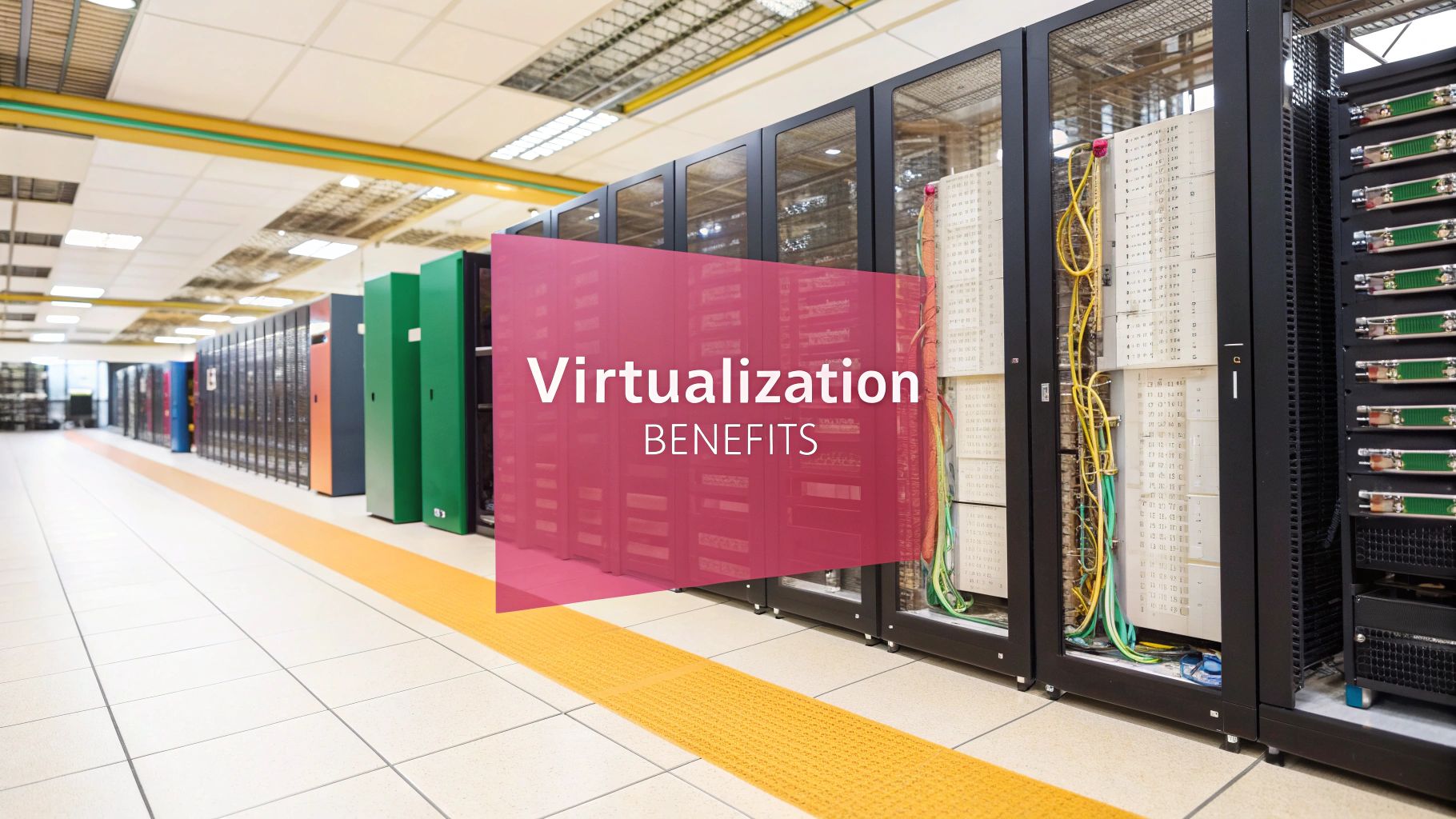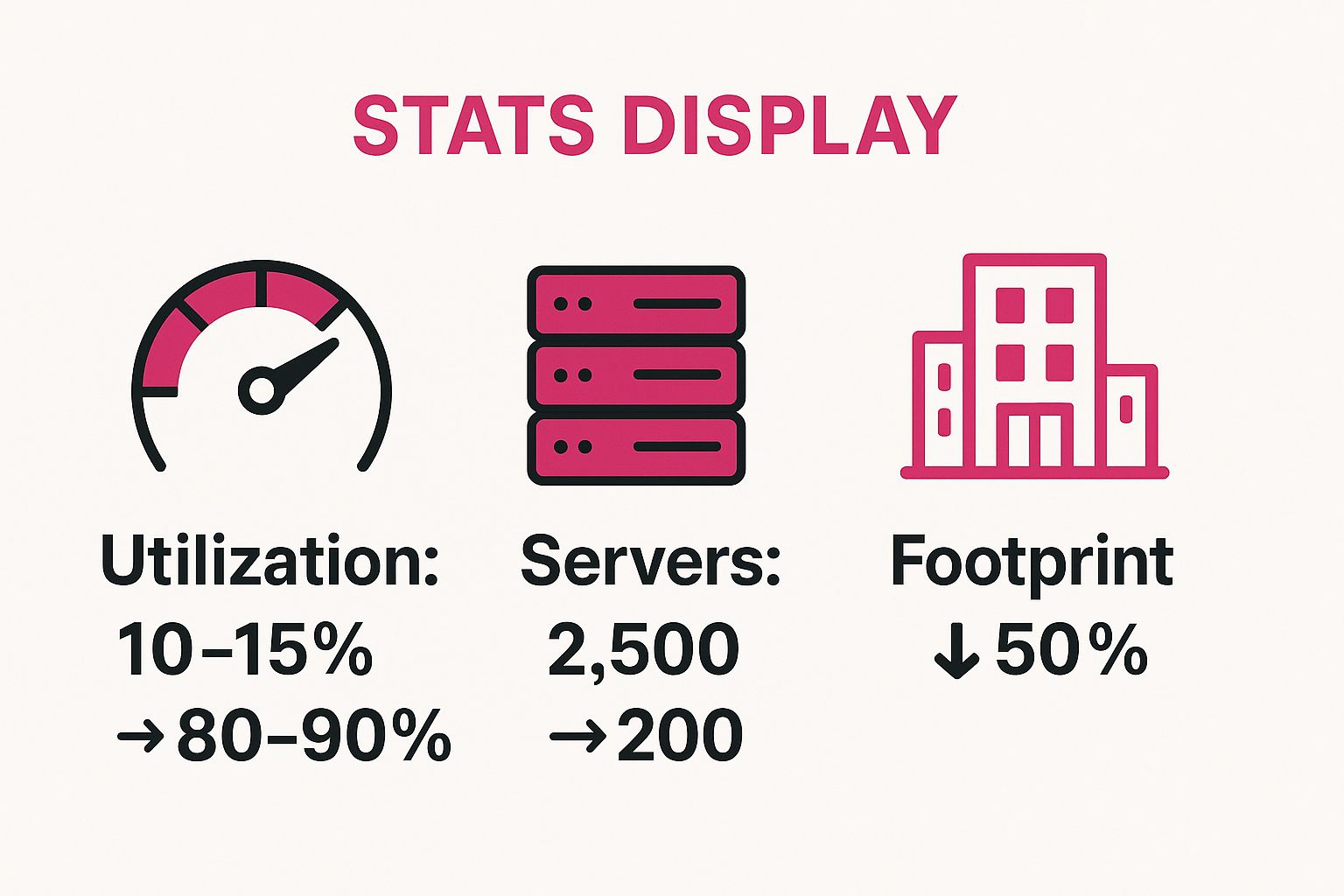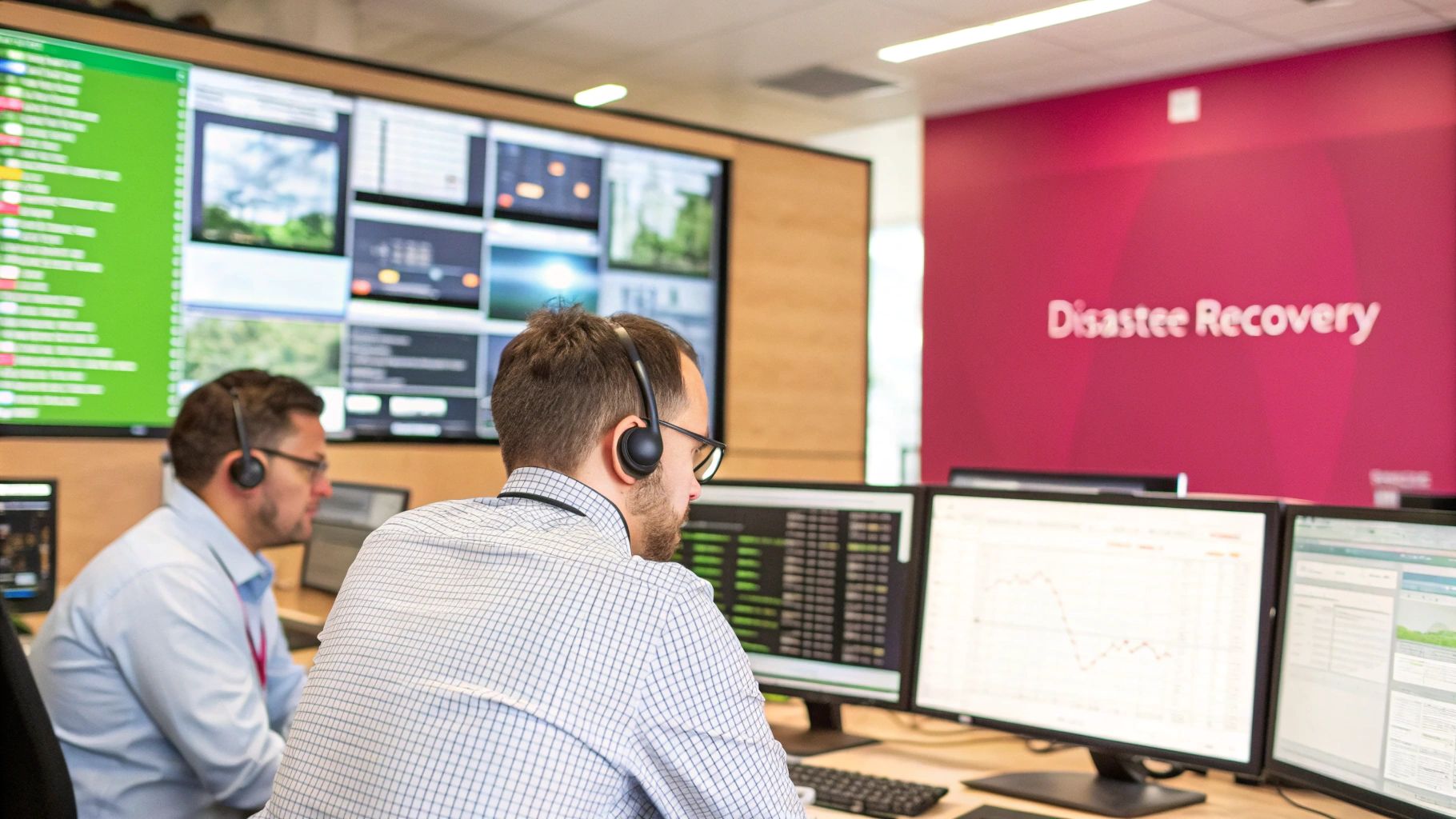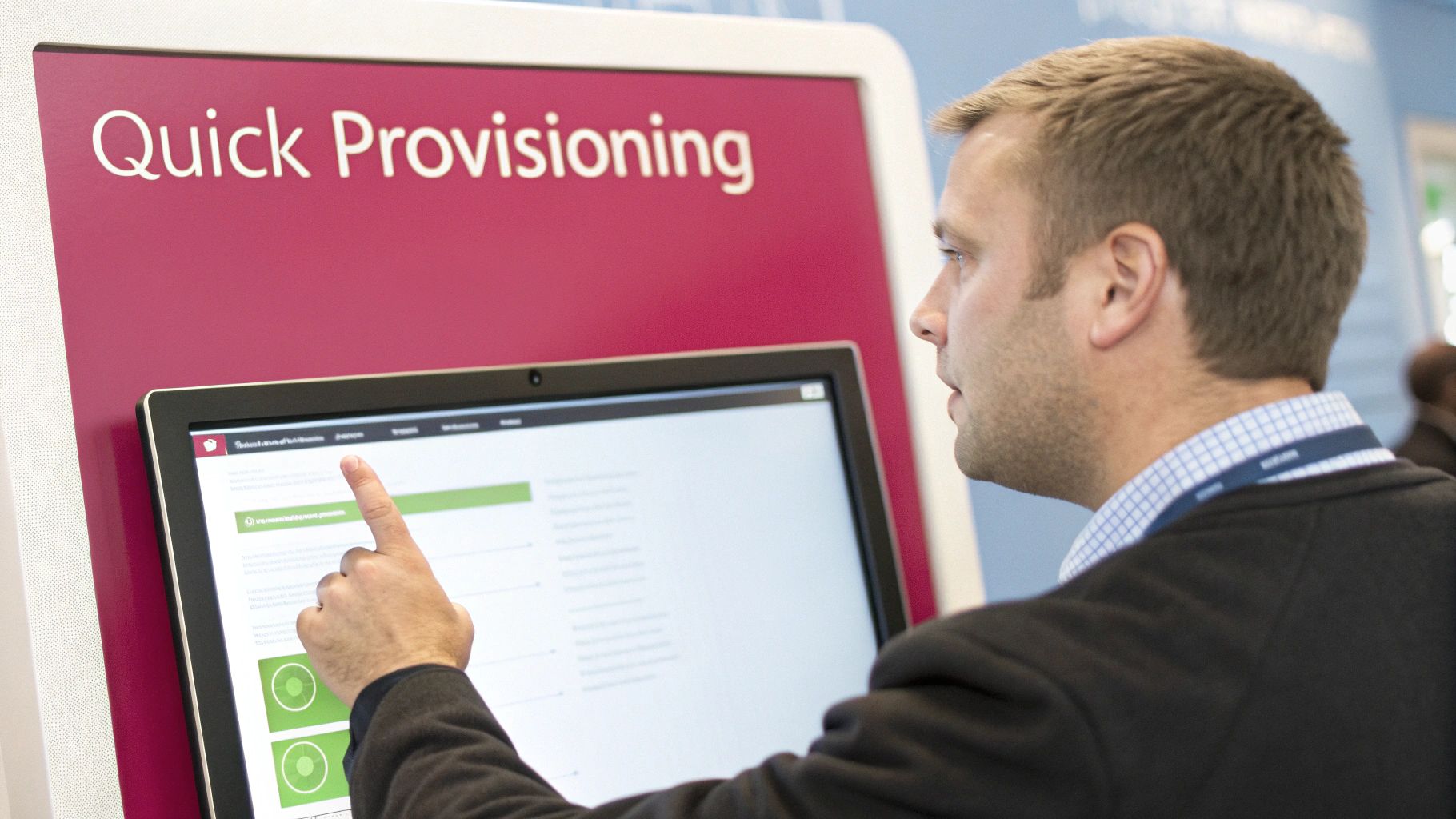Discover the top server virtualization benefits for professional services. Boost efficiency, cut costs, and improve disaster recovery with our expert guide.

In today's competitive landscape, UK small and medium-sized enterprises (SMEs) are constantly seeking ways to optimise operations, reduce overheads, and enhance resilience. Many are still grappling with underutilised physical servers, escalating energy bills, and rigid IT infrastructure that hampers growth. This is where server virtualisation steps in, not as complex technical jargon, but as a pragmatic solution to these persistent challenges. By creating multiple virtual machines (VMs) on a single physical server, businesses can dramatically improve resource utilisation, streamline management, and build a more agile, cost-effective IT foundation.
This article explores the eight most impactful server virtualisation benefits, providing practical examples and actionable insights tailored for professional services firms. We will delve into how this technology can transform your infrastructure from a capital expense into a strategic asset, covering everything from significant cost reductions and enhanced disaster recovery to improved security and scalability. For organisations in Dorset, Somerset, and the surrounding counties, understanding these advantages is the first step toward future-proofing operations. We will examine how this transformative approach, implemented correctly, allows you to do more with less, ensuring your IT infrastructure actively supports your business goals rather than constraining them.
One of the most immediate and tangible server virtualisation benefits for any small to medium-sized enterprise (SME) is the significant reduction in both capital and operational expenditure. The traditional one-application-per-server model is notoriously inefficient, often leaving physical servers vastly underutilised. Virtualisation flips this model on its head.
By creating multiple, isolated virtual machines (VMs) on a single physical server, you can consolidate your hardware footprint dramatically. This allows you to safely run different applications and operating systems side-by-side on one machine. The result is a monumental leap in efficiency, boosting typical hardware utilisation from a mere 10-15% to an impressive 80% or more. This consolidation has a powerful ripple effect across your entire IT budget.
The following infographic illustrates the direct impact of a typical server consolidation project.

These figures demonstrate how a strategic shift to virtualisation directly translates into fewer physical assets and a smaller operational footprint, freeing up capital for core business activities.
For professional services firms, this is not just a theoretical advantage; it delivers measurable results. Consider a Dorset-based legal practice that consolidated 15 ageing servers running case management, email, and file services onto just two modern physical hosts. This move reduced their annual IT power and cooling bill by over 60% and allowed them to avoid a costly office expansion. Similarly, a Wiltshire-based accountancy practice cut their server hardware replacement budget by 75% over a five-year cycle by adopting a virtualised infrastructure.
To realise these benefits, a structured approach is essential.
Beyond hardware consolidation, one of the most powerful server virtualisation benefits is the dramatic improvement in disaster recovery (DR) capabilities. In a traditional physical environment, restoring a server after a catastrophic failure is a slow, manual process involving sourcing compatible hardware and reinstalling operating systems from scratch. Virtualisation transforms this entire paradigm.
By encapsulating an entire server—including its operating system, applications, and data—into a few portable files, a virtual machine (VM) becomes hardware-independent. This means you can back up, replicate, and restore your entire server environment to any other physical host, often in a matter of minutes rather than days. This agility is the cornerstone of modern business continuity planning, minimising downtime and protecting revenue.

This fundamental shift in recovery methodology significantly reduces Recovery Time Objectives (RTOs) and Recovery Point Objectives (RPOs), ensuring your business can withstand unexpected disruptions. For businesses looking to strengthen their operational resilience, learning more about a modern business continuity solution can provide crucial insights.
The impact of virtualised DR is evident across professional services. For instance, a Somerset-based logistics company used VM replication to fail over its entire operations to a secondary site in under 30 minutes during a major power outage, preventing any disruption to its delivery schedules. Similarly, during a server room flood, a Hampshire-based financial advisory firm restored its client database and core applications from replicated VM backups within an hour, avoiding significant data loss and regulatory penalties. These are tangible examples of how this technology protects businesses.
A proactive approach is key to leveraging virtualisation for robust business continuity.
Another of the key server virtualisation benefits is the ability to adapt your IT infrastructure to changing business demands with unprecedented speed and precision. In a traditional physical environment, scaling resources meant a slow and costly process of procuring and installing new hardware. Virtualisation transforms this by abstracting resources from the underlying physical machines.
This abstraction allows for the dynamic allocation of computing power, memory, and storage to any virtual machine as needed. If an application, like your client relationship management (CRM) system, experiences a surge in demand during a marketing campaign, you can instantly assign it more resources. This ensures optimal performance without overprovisioning or physical intervention, giving your business the agility to respond to market opportunities effectively.
For professional services firms, this flexibility is a powerful competitive advantage. Consider a Somerset-based e-commerce business that experiences a huge spike in website traffic during the Christmas period. Using a virtualised environment, they can temporarily allocate additional CPU and RAM to their web server VMs to handle the load, then scale back down in January, paying only for the resources they actually use. This is a core principle shared with cloud computing, offering SMEs an enterprise-level capability. For a deeper look, you can learn more about cloud computing benefits for businesses on sescomputers.com.
To harness this scalability, a managed approach is crucial.
In the competitive landscape of modern business, speed and agility are paramount. One of the most transformative server virtualisation benefits is the dramatic acceleration of server provisioning and deployment, moving IT operations from a reactive to a proactive model. The traditional approach, which involves ordering, installing, and configuring physical hardware, can take weeks or even months. Virtualisation eradicates this bottleneck entirely.
By leveraging pre-configured templates, new virtual machines can be cloned and deployed in minutes. This agility allows businesses to respond instantly to new opportunities, scale services on demand, and accelerate development cycles. Instead of waiting for hardware, teams can get the resources they need almost immediately, fostering innovation and boosting productivity. For instance, if your business needs to rapidly deploy new services, such as setting up a self-hosted email server, virtualisation significantly streamlines this process.

This ability to rapidly deploy IT infrastructure is no longer exclusive to large enterprises; it is a critical advantage that SMEs can leverage to stay competitive and responsive in a fast-paced market.
The impact of rapid deployment is clear across professional services. A Somerset-based software development company, for example, adopted virtual machine templates to provide its developers with isolated testing environments on demand. This simple change cut their project setup time from two days to under 15 minutes per developer, massively accelerating their release schedule. Similarly, a Hampshire-based accountancy firm uses VM cloning to deploy a new server for a specific client project, ensuring complete data segregation and rapid setup without any hardware lead time.
To harness the speed of virtualisation, a strategic approach is key.
Another of the core server virtualisation benefits is a dramatically improved security posture through workload isolation. In a traditional physical environment, a security breach on one application could potentially spread across the server to others. Virtualisation fundamentally changes this dynamic by creating robust, software-defined boundaries.
Each virtual machine (VM) operates as a self-contained unit with its own virtual hardware, kernel, and operating system, completely isolated from other VMs on the same physical host. This containment means that if one VM is compromised by malware or a targeted attack, the breach is confined within that single virtual environment. This prevents lateral movement across your network, effectively containing the threat and protecting your other critical applications and data.
This layered defence mechanism is not merely a theoretical advantage; it is a foundational principle of modern cybersecurity architecture. By segmenting workloads, you significantly reduce the attack surface and limit the potential impact of any single security incident, which is crucial for maintaining operational integrity and meeting compliance requirements.
For professional services firms, particularly those handling sensitive client data like legal or financial practices, this level of isolation is a game-changer. Consider a Somerset-based financial advisory firm that must comply with strict data protection regulations. By running their client management system, email server, and accounting software in separate, isolated VMs, they ensure that a vulnerability in one system cannot compromise the others. This compartmentalisation provides a clear, auditable trail and simplifies the process of demonstrating regulatory compliance.
A strategic approach is required to leverage virtualisation for maximum security benefit.
Beyond operational efficiency, one of the most powerful server virtualisation benefits is its ability to revolutionise the software development lifecycle. Traditionally, setting up a new testing or development environment was a cumbersome process requiring dedicated physical hardware, complex configuration, and significant time investment. Virtualisation eliminates these barriers entirely.
By abstracting software from hardware, developers can instantly provision and decommission isolated virtual environments. This allows them to create sandboxes that precisely mimic production setups or test applications across a wide array of operating systems and configurations simultaneously on a single physical machine. This agility accelerates innovation, reduces time-to-market, and allows for more thorough and reliable testing, significantly improving final product quality.
This capability is a game-changer for businesses that develop bespoke software or need to test updates before deployment. For instance, a Somerset-based software house developing applications for financial services can spin up multiple VMs to test compatibility against different versions of Windows and SQL Server. This process, which once took days, now takes minutes, allowing for rapid iteration. Similarly, a Hampshire-based architectural practice can use virtual environments to safely test updates to its CAD software and plugins without ever risking the live production system.
To leverage virtualisation effectively in your development process, a strategic approach is key.
One of the most powerful server virtualisation benefits for any SME is the dramatic enhancement of system availability and business continuity. In a traditional physical server environment, hardware maintenance or failure inevitably leads to downtime. Virtualisation architecture introduces sophisticated features that minimise or eliminate this service disruption.
By decoupling the operating system and applications from specific hardware, virtual machines (VMs) can be moved between physical hosts without any interruption to end-users. This capability, known as live migration, is a cornerstone of high availability. Features like automated failover, pioneered by solutions like VMware vSphere HA and Microsoft Failover Clustering, automatically restart VMs on another host if the original hardware fails, ensuring services are restored in minutes, not hours.
For professional services firms, where system uptime is non-negotiable, these features are essential. Consider a Hampshire-based accountancy practice that relies on its core tax software during peak season. Using live migration, their IT provider can perform essential hardware maintenance during working hours with zero impact on the accountants using the system. Similarly, a Somerset-based care provider can ensure its critical patient management system remains online, even in the event of a server hardware failure, thanks to automated failover protecting its virtualised applications.
Achieving near-continuous uptime requires careful planning and a robust setup.
Beyond direct cost savings and operational improvements, one of the most significant server virtualisation benefits is its positive impact on environmental sustainability. Embracing green IT is not only a corporate responsibility but also a tangible business advantage. The traditional model of one server per application is incredibly wasteful, consuming vast amounts of power and generating significant heat.
By consolidating multiple physical servers into fewer, more powerful hosts, virtualisation directly tackles this inefficiency. This consolidation drastically reduces the overall energy required for powering and cooling your IT infrastructure. Fewer machines mean a smaller physical footprint, less electronic waste (e-waste) at the end of the hardware lifecycle, and a measurable reduction in your organisation's carbon footprint. This allows SMEs to achieve their operational goals while demonstrating a commitment to environmental stewardship.
This move towards sustainability delivers clear, measurable outcomes. For professional services firms, this can be a key differentiator. A Somerset-based manufacturing firm, by virtualising its production and administrative servers, reduced its server room's energy consumption by an estimated 70%. This directly lowered its operational overheads and supported its ISO 14001 environmental management certification, strengthening its position in supply chain tenders that prioritise sustainability. A Dorset-based marketing agency similarly highlighted its reduced carbon footprint in client proposals, aligning with the green values of its target market.
To leverage these environmental benefits effectively, a strategic approach is key.
The journey through the core server virtualisation benefits reveals a transformative strategy, not just an IT upgrade. We have moved beyond the traditional one-server, one-application model, demonstrating how consolidating hardware leads to direct and significant cost reductions for businesses across Dorset and the surrounding counties. From lower capital expenditure on physical machines to reduced energy consumption and cooling needs, the financial case is compelling. Yet, the advantages extend far beyond the balance sheet, fundamentally reshaping an organisation's agility, resilience, and security posture.
We have explored how virtualisation enhances disaster recovery, turning a complex, often unreliable process into a streamlined and predictable one. Imagine a Wiltshire-based accountancy practice being able to restore its entire server environment in minutes, not days, after a critical failure. This is the power of virtual machine snapshots and replication. Furthermore, the ability to rapidly provision new servers allows a Somerset care provider to deploy a new patient management application in hours, not weeks, responding instantly to operational needs. This level of flexibility is simply unattainable in a purely physical environment.
Understanding these benefits is the first step; implementing them successfully is the next. A successful transition to a virtualised environment requires a strategic approach, moving beyond a simple lift-and-shift of existing servers. It involves careful planning and a deep understanding of your specific business workloads.
Key takeaways to guide your next steps include:
The overarching theme is that server virtualisation is a foundational technology for a modern, competitive business. It is the bedrock upon which more advanced cloud strategies, scalable applications, and robust cybersecurity frameworks are built. Embracing this technology is not merely about optimising IT; it is about future-proofing your entire operation, enabling you to adapt, innovate, and thrive in an increasingly digital landscape.
Ready to harness the full spectrum of server virtualisation benefits for your business? For over 30 years, SES Computers has specialised in designing, implementing, and supporting robust VMware and cloud solutions for organisations across Dorset, Somerset, Wiltshire, and Hampshire. Contact our expert team at SES Computers today for a no-obligation consultation and let us help you build a more efficient, resilient, and agile IT foundation.